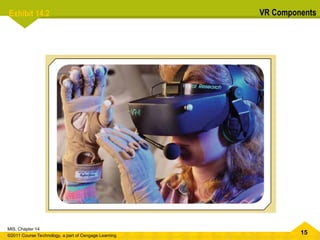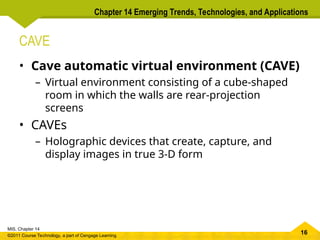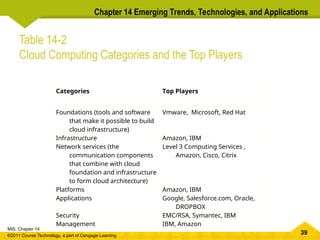More Related Content
978111153396021564865186874_PPT_ch14.ppt 9781111533960_PPT_ch14.ppt 9781111533960_PPT_ch14.ppt 9781111533960_PPT_ch14.ppt PPt for MIS, emerging trends, and application9781111533960_PPT_ch14.ppt 9781111533960_PPT_ch14.ppt MIS emerging trends and technology applications Similar to 9781111533960_PPT_ch14 .ppt (20)
MOST ADVANCED TECHNOLOGIES AROUND THE WORLD Latest Trends in Information Technology - 2020 Solution Focused Virtual Reality Development Top 10 Emerging Technology in 2022.docx Latest trends in information technology The Metaverse and Virtual Reality 2015 Software Development Trends Copy of Business Geometric Template.pdf K4b Technology Innovation — Trends and Opportunities.pptx informationtech1-180930175759.pptx BetaGroup - Tech Trends in 2017, a snap shot by BetaGroup cbse class 12 power point emerging trends12.pptx class 12 cbse board emerging trends12.pptx World Economic Forum Metaverse Ecosystem By Utpal Chakraborty.pdf presentation sur Virtual Reality english.pptx Emerging Technologies- Making Great Things Possible More from iamayesha2526 (20)
Oracle-Database-Security-and-Compliance.pptx Web-Engineering-Lec-23 .pptx Web-Engineering-Lec-14 (1) .pptx ch02-240507064009-ac337bf1 .ppt Web-Engineering-Lec-14 (1 ).pptx Internet-of-Things-IoT-Databases-and-Edge-Computing (1).pptx Cloud Base db Administration .pptx MACHINE LEARNING MODELS. pptx Advanced_SQL_Injection .ppt Employees Motivation .pptx ControllingFOrOrganization .pptx Advanced_SQL_Injection .ppt LABTASK(view,synonymjjjjjjjjjjjjjjjjjjjjjjjjjjjjjj).docx ch5-process-synchronization. pdf Intro To management chapter 6 Decision Making Recently uploaded (20)
mahatma gandhi bus terminal in india Case Study.pptx LITERATURE CASE STUDY DESIGN SEMESTER 5.pptx Special finishes, classification and types, explanation EGWHermeneuticsffgggggggggggggggggggggggggggggggg.ppt YV PROFILE PROJECTS PROFILE PRES. DESIGN Key Trends in Website Development 2025 | B3AITS - Bow & 3 Arrows IT Solutions An introduction to AI in research and reference management BRANDBOOK-Presidential Award Scheme-Kenya-2023 The Advantages of Working With a Design-Build Studio rapid fire quiz in your house is your india.pptx 12. Community Pharmacy and How to organize it UNIT 1 Introduction fnfbbfhfhfbdhdbdto Java.pptx.pdf Tenders & Contracts Works _ Services Afzal.pptx HPE Aruba-master-icon-library_052722.pptx ANATOMY OF ANTERIOR CHAMBER ANGLE AND GONIOSCOPY.pptx The story of the first moon landing.docx AC-Unit1.pptx CRYPTOGRAPHIC NNNNFOR ALL Trusted Executive Protection Services in Ontario — Discreet & Professional.pdf areprosthodontics and orthodonticsa text.pptx BSCS lesson 3.pptxnbbjbb mnbkjbkbbkbbkjb 9781111533960_PPT_ch14 .ppt
- 1. 1
MIS, Chapter 14
©2011 Course Technology, a part of Cengage Learning
EMERGING TRENDS,
TECHNOLOGIES, AND
APPLICATIONS
CHAPTER 14
Hossein BIDGOLI
MIS
- 2. 2
MIS, Chapter 14
©2011 Course Technology, a part of Cengage Learning
Chapter 14 Emerging Trends, Technologies, and Applications
LO1 Summarize new trends in software and service
distribution.
LO2 Describe virtual reality components and
applications.
LO3 Discuss uses of radio frequency identification.
LO4 Summarize new uses of biometrics.
LO5 Explain new trends in networking, including
wireless technologies and grid and cloud computing.
l e a r n i n g o u t c o m e s
- 3. 3
MIS, Chapter 14
©2011 Course Technology, a part of Cengage Learning
LO6 Discuss uses of nanotechnology.
l e a r n i n g o u t c o m e s (cont’d.)
Chapter 14 Emerging Trends, Technologies, and Applications
- 4. 4
MIS, Chapter 14
©2011 Course Technology, a part of Cengage Learning
Chapter 14 Emerging Trends, Technologies, and Applications
Trends in Software and Service Distribution
• Recent trends in software and service
distribution include:
– Pull and push technologies
– Application service providers
- 5. 5
MIS, Chapter 14
©2011 Course Technology, a part of Cengage Learning
Chapter 14 Emerging Trends, Technologies, and Applications
Pull and Push Technologies
• Pull technology
– User states a need before getting information
– Entering a URL in a Web browser to go to a certain
Web site
• Push technology (Webcasting)
– Web server delivers information to users who have
signed up for this service
– Supported by many Web browsers
– Also available from vendors
– Delivers content to users automatically at set intervals
or when a new event occurs
- 6. 6
MIS, Chapter 14
©2011 Course Technology, a part of Cengage Learning
Chapter 14 Emerging Trends, Technologies, and Applications
Pull and Push Technologies (cont’d.)
• Examples of push technology:
– “A newer version of Adobe Flash is available.
Would you like to install it?”
– Research In Motion (RIM) offers a new BlackBerry
push API
– Microsoft Direct Push from AT&T
- 7. 7
MIS, Chapter 14
©2011 Course Technology, a part of Cengage Learning
Chapter 14 Emerging Trends, Technologies, and Applications
Application Service Providers
• Application service providers (ASPs)
– Provide access to software or services for a fee
• Software as a service (SaaS), or on-demand
software
– Model for ASPs to deliver software to users for a
fee
– Software might be for temporary or long-term use
– Users don’t need to be concerned with new
software versions and compatibility problems
- 8. 8
MIS, Chapter 14
©2011 Course Technology, a part of Cengage Learning
Chapter 14 Emerging Trends, Technologies, and Applications
Application Service Providers (cont’d.)
• Users can also save all application data on the
ASP’s server
– Software and data are portable
• The SaaS model can take several forms:
– Software services for general use
– Offering a specific service
– Offering a service in a vertical market
- 9. 9
MIS, Chapter 14
©2011 Course Technology, a part of Cengage Learning
Chapter 14 Emerging Trends, Technologies, and Applications
Application Service Providers (cont’d.)
• Advantages:
– Similar to outsourcing
• Less expensive
• Delivering information more quickly
• Other advantages and disadvantages
• Vendors:
– Google, NetSuite, Inc., and Salesforce.com
- 10. 10
MIS, Chapter 14
©2011 Course Technology, a part of Cengage Learning
Chapter 14 Emerging Trends, Technologies, and Applications
Virtual Reality
• Goal of virtual reality (VR):
– Create an environment in which users can interact
and participate as they do in the real world
• VR technology
– Uses computer-generated, three-dimensional
images to create the illusion of interaction in a
real-world environment
- 11. 11
MIS, Chapter 14
©2011 Course Technology, a part of Cengage Learning
Chapter 14 Emerging Trends, Technologies, and Applications
Virtual Reality (cont’d.)
• VR terms:
– Simulation
– Interaction
– Immersion
– Telepresence
– Full-body immersion
– Networked communication
- 12. 12
MIS, Chapter 14
©2011 Course Technology, a part of Cengage Learning
Chapter 14 Emerging Trends, Technologies, and Applications
Types of Virtual Environments
• Egocentric environment
– User is totally immersed in the VR world
– Most common technology used with this
environment is a head-mounted display (HMD)
• Exocentric environment
– Data is still rendered in 3-D
– Users can only view it onscreen
– Main technology used in this environment is 3-D
graphics
- 14. 14
MIS, Chapter 14
©2011 Course Technology, a part of Cengage Learning
Chapter 14 Emerging Trends, Technologies, and Applications
Components of a Virtual Reality System
• Visual and aural systems
• Manual control for navigation
• Central coordinating processor and software
system
• Walker
- 16. 16
MIS, Chapter 14
©2011 Course Technology, a part of Cengage Learning
Chapter 14 Emerging Trends, Technologies, and Applications
CAVE
• Cave automatic virtual environment (CAVE)
– Virtual environment consisting of a cube-shaped
room in which the walls are rear-projection
screens
• CAVEs
– Holographic devices that create, capture, and
display images in true 3-D form
- 17. 17
MIS, Chapter 14
©2011 Course Technology, a part of Cengage Learning
Chapter 14 Emerging Trends, Technologies, and Applications
CAVE (cont’d.)
• People can enter CAVEs in other locations
– No matter how far away they are geographically
• High-speed digital cameras capture one
user’s presence and movements
– Then re-create and send these images to users in
other CAVEs
• Used for research in many fields:
– Archaeology, architecture, engineering, geology,
and physics
- 19. 19
MIS, Chapter 14
©2011 Course Technology, a part of Cengage Learning
Chapter 14 Emerging Trends, Technologies, and Applications
Virtual Reality Applications
• Military flight simulations
• Medicine for “bloodless” surgery
• Entertainment industry
• Will one day be used for user interfaces in
information systems
• Current applications:
– Applications for the disabled
– Architectural design
- 20. 20
MIS, Chapter 14
©2011 Course Technology, a part of Cengage Learning
Chapter 14 Emerging Trends, Technologies, and Applications
Virtual Reality Applications (cont’d.)
– Education
– Flight simulation
– Videoconferencing
– Group support systems
- 21. 21
MIS, Chapter 14
©2011 Course Technology, a part of Cengage Learning
Chapter 14 Emerging Trends, Technologies, and Applications
Obstacles in Using VR Systems
• Not enough fiber-optic cables are currently
available for a VR environment capable of re-
creating a conference
• Problems must be solved:
– Confusion between the VR environment and the
real environment
– Mobility and other problems with HMDs
– Sound representation
– Additional computing power
- 22. 22
MIS, Chapter 14
©2011 Course Technology, a part of Cengage Learning
Chapter 14 Emerging Trends, Technologies, and Applications
Virtual Worlds
• Simulated environment designed for users to
interact via avatars
• Avatar
– 2-D or 3-D graphical representation of a person in
the virtual world
– Used in chat rooms and online games
• Gartner Group predicts that 80% of active
Internet users will interact in virtual worlds by
2011
- 23. 23
MIS, Chapter 14
©2011 Course Technology, a part of Cengage Learning
Chapter 14 Emerging Trends, Technologies, and Applications
Virtual Worlds (cont’d.)
• With avatars, users can:
– Manipulate objects
– Experience a limited telepresence
– Communicate using text, graphical icons, and
sound
- 24. 24
MIS, Chapter 14
©2011 Course Technology, a part of Cengage Learning
Chapter 14 Emerging Trends, Technologies, and Applications
Virtual Worlds (cont’d.)
• Widely used virtual worlds:
– Active Worlds
– Club Penguin
– EGO
– Entropia Universe
– Habbo
– Runescape
– Second Life
- 25. 25
MIS, Chapter 14
©2011 Course Technology, a part of Cengage Learning
Chapter 14 Emerging Trends, Technologies, and Applications
Virtual Worlds in Action
• Second Life
– Several million members from all over the world
– Some companies use Second Life to establish or
enhance their image, generate sales leads, and
increase sales
• Some experts believe that groups work
together better in virtual worlds than in face-
to-face meetings and teleconferences
- 26. 26
MIS, Chapter 14
©2011 Course Technology, a part of Cengage Learning
Chapter 14 Emerging Trends, Technologies, and Applications
Radio Frequency Identification: An Overview
• Radio frequency identification (RFID) tag
– Small electronic device consisting of a small chip
and an antenna
– Provides a unique identification for the card or the
object carrying the tag
– Don’t have to be in contact with the scanner to be
read
– Can be read from a distance of about 20 feet
- 27. 27
MIS, Chapter 14
©2011 Course Technology, a part of Cengage Learning
Chapter 14 Emerging Trends, Technologies, and Applications
Radio Frequency Identification: An Overview (cont’d.)
• Two types of RFID tags:
– Passive
• No battery
• Best ones have about 10 years of battery life
– Active
• Usually more reliable than passive tags
• Technical problems and issues of privacy and
security
- 28. 28
MIS, Chapter 14
©2011 Course Technology, a part of Cengage Learning
Table 14.1 RFID Applications
RFID Applications
Category Examples
Tracking and identification Railway cars and shipping containers, livestock and
pets, supply-chain management (tracking
merchandise from manufacturers to retailers to
customers), inventory control,
retail checkout and POS systems, recycling and waste
disposal
Payment and stored-value systems Electronic toll systems, contactless credit cards
(require no swiping), subway and bus passes, casino tokens,
concert tickets
Access control Building access cards, ski-lift passes, car ignition
systems
Anticounterfeiting Casino tokens, high-denomination currency notes,
luxury goods, prescription drugs
Health care Tracking medical tools and patients
(particularly newborns and patients with Alzheimer’s),
process control, monitoring patient data
- 29. 29
MIS, Chapter 14
©2011 Course Technology, a part of Cengage Learning
Chapter 14 Emerging Trends, Technologies, and Applications
Biometrics: A Second Look
• Current and future applications of biometrics:
– ATM, credit, and debit cards
– Network and computer login security
– Web page security
– Voting
– Employee time clocks
– Airport security and fast check-in
– Passports and highly secured government ID cards
– Sporting events
– Cell phones and smart cards
- 30. 30
MIS, Chapter 14
©2011 Course Technology, a part of Cengage Learning
Chapter 14 Emerging Trends, Technologies, and Applications
Trends in Networking
• Recent trends in networking technologies
• Many are already used in many organizations
– Wireless technologies and grid computing
• Newer but attracting a lot of attention:
– WiMAX and cloud computing
- 31. 31
MIS, Chapter 14
©2011 Course Technology, a part of Cengage Learning
Chapter 14 Emerging Trends, Technologies, and Applications
Wi-Fi
• Wireless Fidelity (Wi-Fi)
– Broadband wireless technology
– Based on the 802.11a, 802.11b, 802.11g, and 802.11n
standards
• Information can be transmitted over short
distances
– In the form of radio waves
• Connect via:
– Computers, mobile phones and smart phones, MP3
players, PDAs, and game consoles
– Wi-Fi hotspots
- 32. 32
MIS, Chapter 14
©2011 Course Technology, a part of Cengage Learning
Chapter 14 Emerging Trends, Technologies, and Applications
WiMAX
• Worldwide Interoperability for Microwave
Access (WiMAX)
– Broadband wireless technology
– Based on the IEEE 802.16 standards
• Designed for wireless metropolitan area networks
• Theoretically has faster data transfer rates and a
longer range than Wi-Fi
• Disadvantages:
– Interference from other wireless devices, high costs, and
interruptions from weather conditions
- 33. 33
MIS, Chapter 14
©2011 Course Technology, a part of Cengage Learning
Chapter 14 Emerging Trends, Technologies, and Applications
Bluetooth
• Can be used to create a personal area
network (PAN)
• Wireless technology for transferring data over
short distances
• Specifications are developed and licensed by
the Bluetooth Special Interest Group
• Uses a radio technology called Frequency
Hopping Spread Spectrum (FHSS)
- 34. 34
MIS, Chapter 14
©2011 Course Technology, a part of Cengage Learning
Chapter 14 Emerging Trends, Technologies, and Applications
Bluetooth (cont’d.)
• Used to connect devices such as:
– Computers, global positioning systems (GPSs),
mobile phones, laptops, printers, and digital
cameras
• No line-of-sight limitations
• Limited transfer rate
- 35. 35
MIS, Chapter 14
©2011 Course Technology, a part of Cengage Learning
Chapter 14 Emerging Trends, Technologies, and Applications
Grid Computing
• Connecting different computers to combine their
processing power to solve a particular problem
• “Node”
– Each participant in a grid
• Processing on overused nodes can be switched
to idle servers and even desktop systems
• Advantages:
– Improved reliability
– Parallel processing nature
– Scalability
- 36. 36
MIS, Chapter 14
©2011 Course Technology, a part of Cengage Learning
Chapter 14 Emerging Trends, Technologies, and Applications
Utility (On-Demand) Computing
• Similar to the SaaS model
• Provides IT services on demand
• Users pay for computing or storage resources
on an as-needed basis
• Main advantages
– Convenience and cost savings
• Drawbacks
– Privacy and security
- 37. 37
MIS, Chapter 14
©2011 Course Technology, a part of Cengage Learning
Chapter 14 Emerging Trends, Technologies, and Applications
Cloud Computing
• Platform incorporating many recent
technologies under one platform, including:
– SaaS model, Web 2.0, grid computing, and utility
computing
• Variety of resources can be provided to users
over the Internet
• Example:
– Editing Word document on an iPhone
• Same advantages and disadvantages as
distributed computing
- 38. 38
MIS, Chapter 14
©2011 Course Technology, a part of Cengage Learning
Chapter 14 Emerging Trends, Technologies, and Applications
Cloud Computing (cont’d.)
• Services typically require a fee
• Some are free
• Google Apps
– Includes Gmail, Google Talk, and Google Docs,
– Provides commonly used applications accessed via
a Web browser
- 39. 39
MIS, Chapter 14
©2011 Course Technology, a part of Cengage Learning
Chapter 14 Emerging Trends, Technologies, and Applications
Table 14-2
Cloud Computing Categories and the Top Players
Categories Top Players
Foundations (tools and software
that make it possible to build
cloud infrastructure)
Vmware, Microsoft, Red Hat
Infrastructure Amazon, IBM
Network services (the
communication components
that combine with cloud
foundation and infrastructure
to form cloud architecture)
Level 3 Computing Services ,
Amazon, Cisco, Citrix
Platforms Amazon, IBM
Applications Google, Salesforce.com, Oracle,
DROPBOX
Security EMC/RSA, Symantec, IBM
Management IBM, Amazon
- 40. 40
MIS, Chapter 14
©2011 Course Technology, a part of Cengage Learning
Chapter 14 Emerging Trends, Technologies, and Applications
Cloud Computing in Action
• Amazon.com
– Established a computing platform that companies
can use, regardless of their location
– Provides storage and processing power on
demand
– Companies pay only for the resources they use
• Google Apps
– Introduced in February 2007
– Competing with Microsoft’s Office Suite
- 41. 41
MIS, Chapter 14
©2011 Course Technology, a part of Cengage Learning
Chapter 14 Emerging Trends, Technologies, and Applications
Nanotechnology
• Incorporates techniques that involve the
structure and composition of materials on a
nanoscale
• Nanometer is one billionth of a meter (10-9
)
• Current technology for making transistors and
other components might reach their
miniaturization limits in the next decade
• Some consumer goods incorporating
nanotechnology are already on the market
– Nanomaterials
- 42. 42
MIS, Chapter 14
©2011 Course Technology, a part of Cengage Learning
Chapter 14 Emerging Trends, Technologies, and Applications
Summary
• New trends:
– Software as a service
– Virtual reality
– RFID
– Networking
– Grid, utility, and cloud computing
– Nanotechnology









































